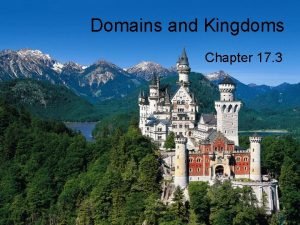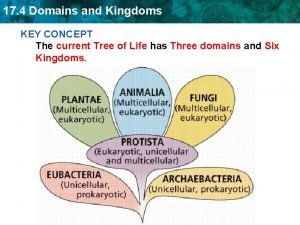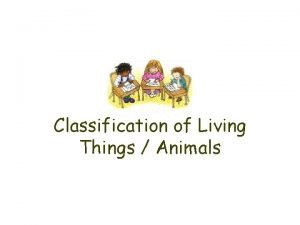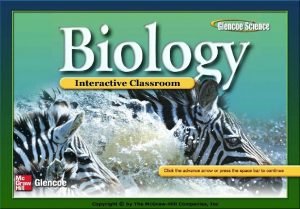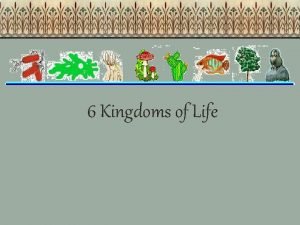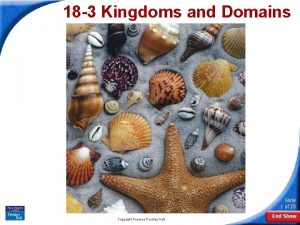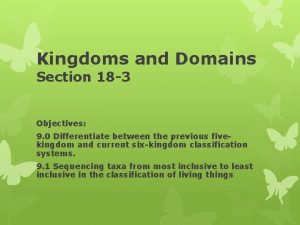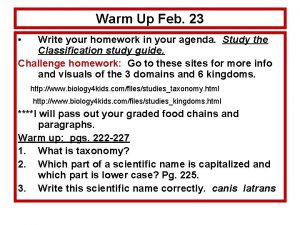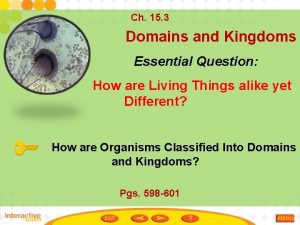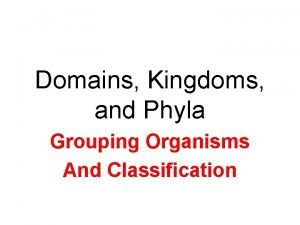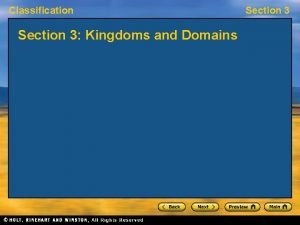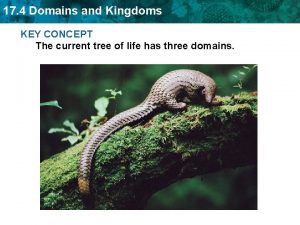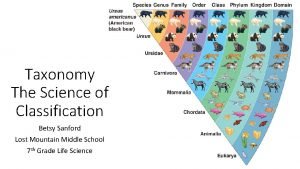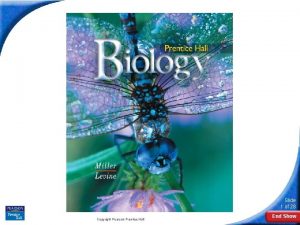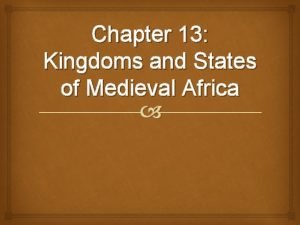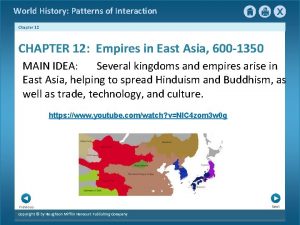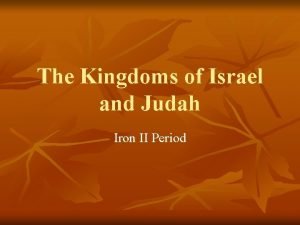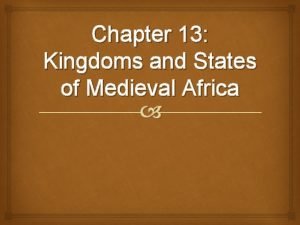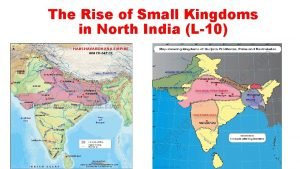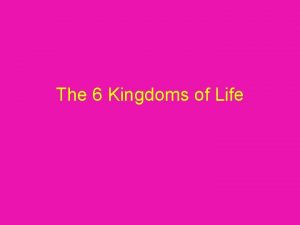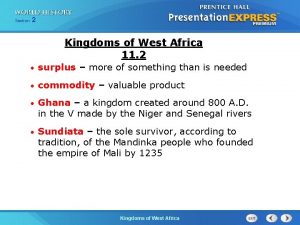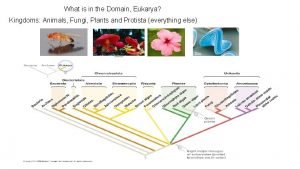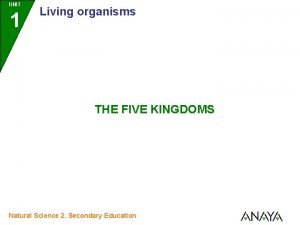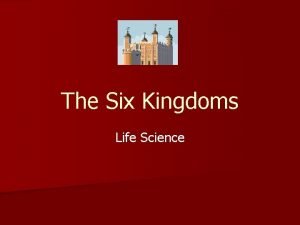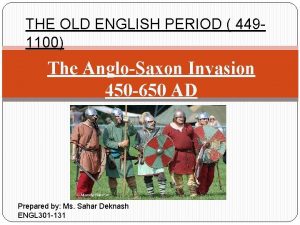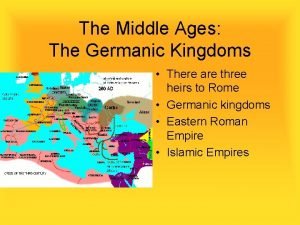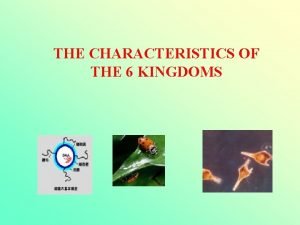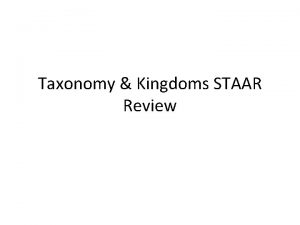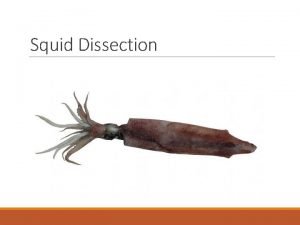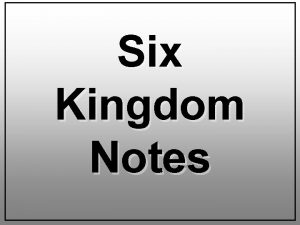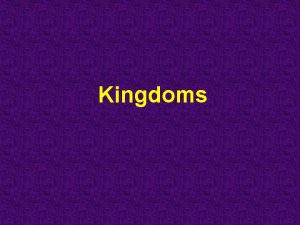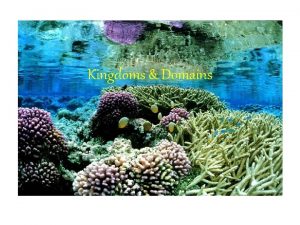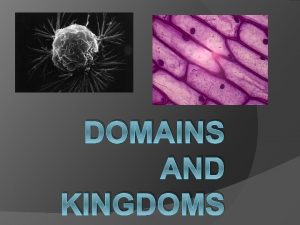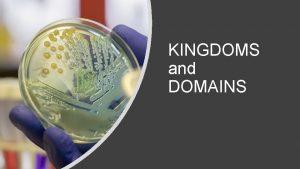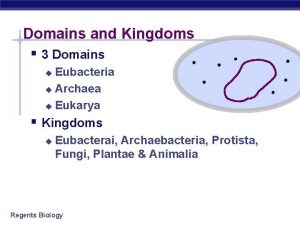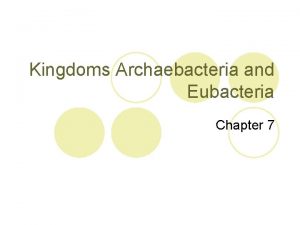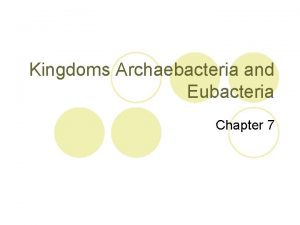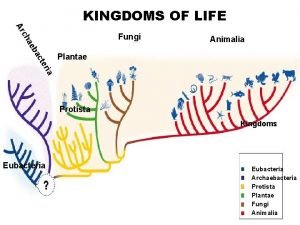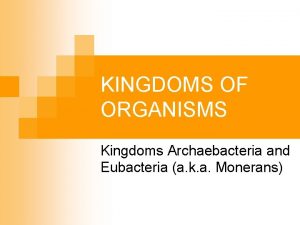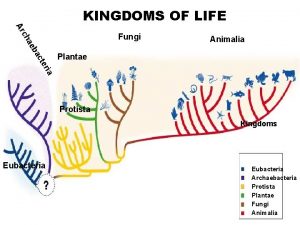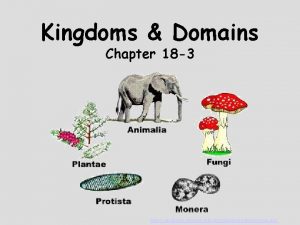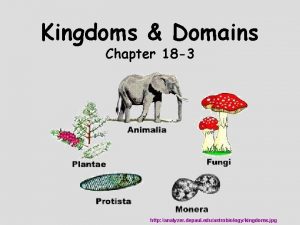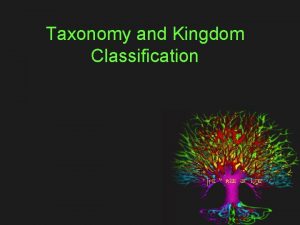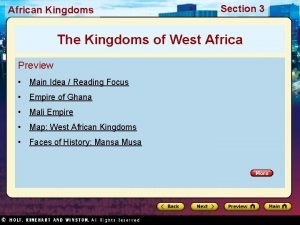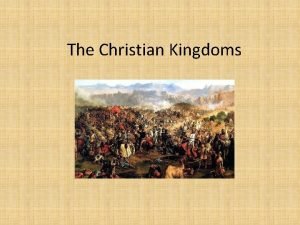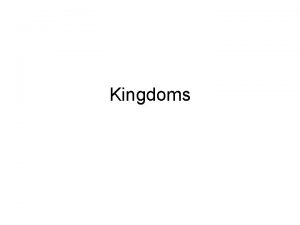Domains and Kingdoms Chapter 17 3 3 Domains





































- Slides: 37

Domains and Kingdoms Chapter 17. 3

3 Domains • Organisms are classified into domains based on cell type and structure – Bacteria – Archaea – Eukaryota

6 Kingdoms • Based on cell type, structure, nutrition – All Bacteria are Eubacteria – All Archaea are Archaebacteria – Eukarya contains: Protista, Fungi, Plantae, Animalia

Kingdom Eubacteria

Domain Bacteria, Kingdom Eubacteria • Bacteria are the most abundant type of organism • Prokaryotes whose cell walls contain peptidoglycan – 2 kinds of sugars form a netlike structure • Porous, strong

Characteristics - Eubacteria • Come in many different shapes • More abundant than any other organism • Can move • Unicellular – No nucleus or organelles

Characteristics - Eubacteria • Eating habits – Heterotrophic – Autotrophic (just a few) • Can survive in many environments – Aerobic – Anaerobic

Eubacteria Cell Type/ Prokaryotes with cell walls made of Structure pepidoglycan Nutrition Most are heterotrophic; some are autotrophic Habitat Live in many environments Mobility Can move

Kingdom Archaebacteria

Domain Archaea – Kingdom Archaebacteria • Most scientists believe Archaea to be more ancient than bacteria. • Main Difference: no peptidoglycan

Characteristics- Archaebacteria • Unicellular • Many shapes • Some autotrophic, most heterotrophic

Extremophiles • Extremophiles – they live in the most extreme environments on Earth – Hot springs – Salty lakes – Thermal vents on ocean floor

Archaebacteria Cell Type/ Prokaryotes with cell walls that are Structure NOT made of peptidoglycan Nutrition Most are heterotrophic; some are autotrophic Habitat Live in many environments Mobility Can move

Domain Eukarya

Domain Eukarya • All organisms with membrane–bound organelles (eukaryotes) • Includes: Kingdom Protista, Kingdom Fungi, Kingdom Plantae, Kingdom Animalia

Kingdom Protista

Kingdom Protista – The Misfits • Don’t fit into any other category • Aren’t similar to each other either. • 3 categories – Plantlike protists – Animal-like protists – Funguslike protists

Plantlike Protists • Autotrophic, perform photosynthesis • Algae – Sea Kelp – Red Algae

Animal-like Protists • Heterotrophic • Do not form organs • Protozoans – amoebas

Funguslike Protists • Euglenoids – have both plantlike and animal-like characteristics • Perform photosynthesis so usually grouped with plantlike protists • Slime molds and mildews

Protista Cell Type/ Unicellular and multicellular eukaryotes Structure Nutrition Autotrophic and heterotrophic Habitat Live in moist environments Mobility Can move

Kingdom Fungi

Characteristics – Kingdom Fungi • More than 70, 000 species • Eukaryotes, absorbs nutrients from organic materials in it’s environment • All are heterotrophs – They secrete digestive enzymes into their food source and then absorb the nutrients directly into their cells

Special Characteristics - Fungi • They can’t move • Cell walls contain chitin – A rigid polymer that gives cells structural support • Have hyphae – Threadlike strands that enable the fungi to grow, feed, and reproduce

Parasitic fungi • Grow and feed on other organisms • Saprobes – eat dead or decaying organic matter • Symbionts – live in a mutualistic relationship with algae (lichens)

Fungi Cell Type/ Unicellular and multicellular eukaryotes Structure with cell walls made of chitin Nutrition heterotrophic Habitat Live in many environments Mobility Cannot move

Kingdom Plantae

Characteristics – Kingdom Plantae • The base of all land habitats - 250, 000 species • Autotrophs - make energy from the sun through photosynthesis – A few are heterotrophs

Plants • Multicellular • Cell walls contain cellulose • Can’t move • Are organized into tissues – Most have organs such as roots, stems, and leaves

Plantae Cell Type/ Multicellular eukaryotes with cell walls Structure made of cellulose Nutrition Habitat Most are autotrophic that perform photosynthesis; some are heterotrophic Live in water and on land Mobility Cannot move

Kingdom Animalia

Characteristics – Kingdom Animalia • Heterotrophs • Multicellular • Eukaryotic • Have membranebound organelles

Animals – Innards • No cell walls • Cells are organized into tissues – Most have tissues that are organized into organs (i. e. skin, stomach, brain) – Organs are often organized into complex systems (i. e. digestive, circulatory)

Animals - Diverse • Range widely in size • Live in water, on land, and in the air • Most can move – Some can’t (i. e. coral can’t move as an adult)

Animalia Cell Type/ Multicellular eukaryotes without cell Structure walls Nutrition heterotrophic Habitat Live in water, on land, and in air Mobility Most can move; some cannot move, such as adult coral

An exception to every system… • A virus is a nucleic acid that is surrounded by a protein coat

Viruses • Viruses have their own classification system • Not considered to be living • They are not cells and do not have cells
 Chapter 17 section 3 domains and kingdoms
Chapter 17 section 3 domains and kingdoms Chapter 17 domains and kingdoms concept mapping answers
Chapter 17 domains and kingdoms concept mapping answers What are the 3 domains and 6 kingdoms of classification
What are the 3 domains and 6 kingdoms of classification Bacteria kingdom characteristics
Bacteria kingdom characteristics What are the 3 domains and 6 kingdoms of classification
What are the 3 domains and 6 kingdoms of classification Chapter 17 section 1 the history of classification
Chapter 17 section 1 the history of classification What are the kingdoms of living things
What are the kingdoms of living things Section 18-3 kingdoms and domains
Section 18-3 kingdoms and domains Section 18-3 kingdoms and domains
Section 18-3 kingdoms and domains Flow chart of domains and kingdoms
Flow chart of domains and kingdoms How are organisms classified into domains and kingdoms
How are organisms classified into domains and kingdoms Two examples of archaebacteria
Two examples of archaebacteria What are the three domains and six kingdoms?
What are the three domains and six kingdoms? Domains and kingdoms
Domains and kingdoms Domains kingdoms and classification 14-15 answer key
Domains kingdoms and classification 14-15 answer key 18-3 kingdoms and domains
18-3 kingdoms and domains Kingdoms and states of medieval africa
Kingdoms and states of medieval africa Chapter 13 kingdoms and states of medieval africa
Chapter 13 kingdoms and states of medieval africa Chapter 12 section 5 kingdoms of southeast asia and korea
Chapter 12 section 5 kingdoms of southeast asia and korea Israel divided into two kingdoms
Israel divided into two kingdoms Lesson quiz 13-1 kingdoms and states of medieval africa
Lesson quiz 13-1 kingdoms and states of medieval africa Small kingdoms in north india
Small kingdoms in north india What are the kingdoms of living things
What are the kingdoms of living things Keys and kingdoms
Keys and kingdoms Kingdom dichotomous key
Kingdom dichotomous key The 6 kingdoms of life
The 6 kingdoms of life How did the kingdoms of west africa develop and prosper
How did the kingdoms of west africa develop and prosper Domain eukarya
Domain eukarya Powerful african kingdoms
Powerful african kingdoms Example of kingdoms
Example of kingdoms Kingdoms of life
Kingdoms of life 4491100
4491100 Germanic kingdoms in the middle ages
Germanic kingdoms in the middle ages Kingdoms of spain map
Kingdoms of spain map 6 animal kingdoms
6 animal kingdoms 6 kingdoms chart
6 kingdoms chart What phylum is a squid
What phylum is a squid Archaebacteria cell type and description
Archaebacteria cell type and description
